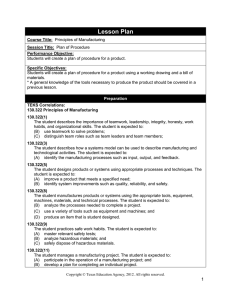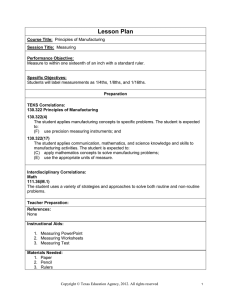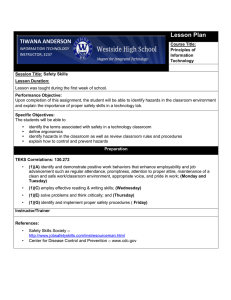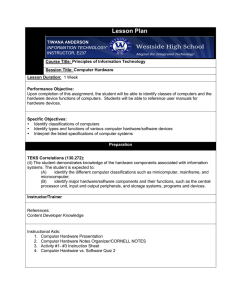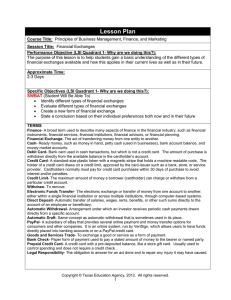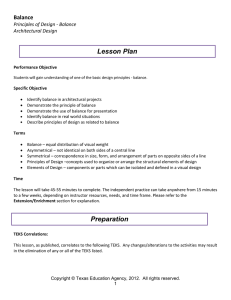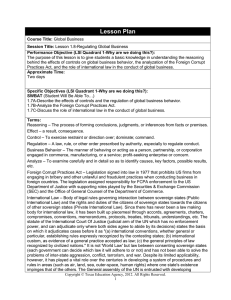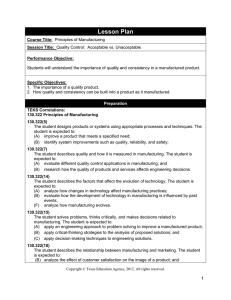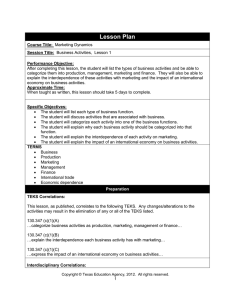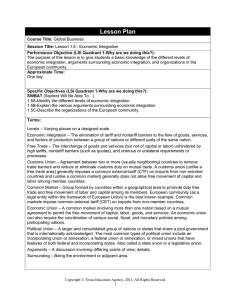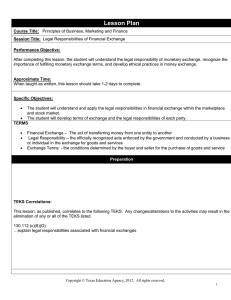Lesson Plan
advertisement
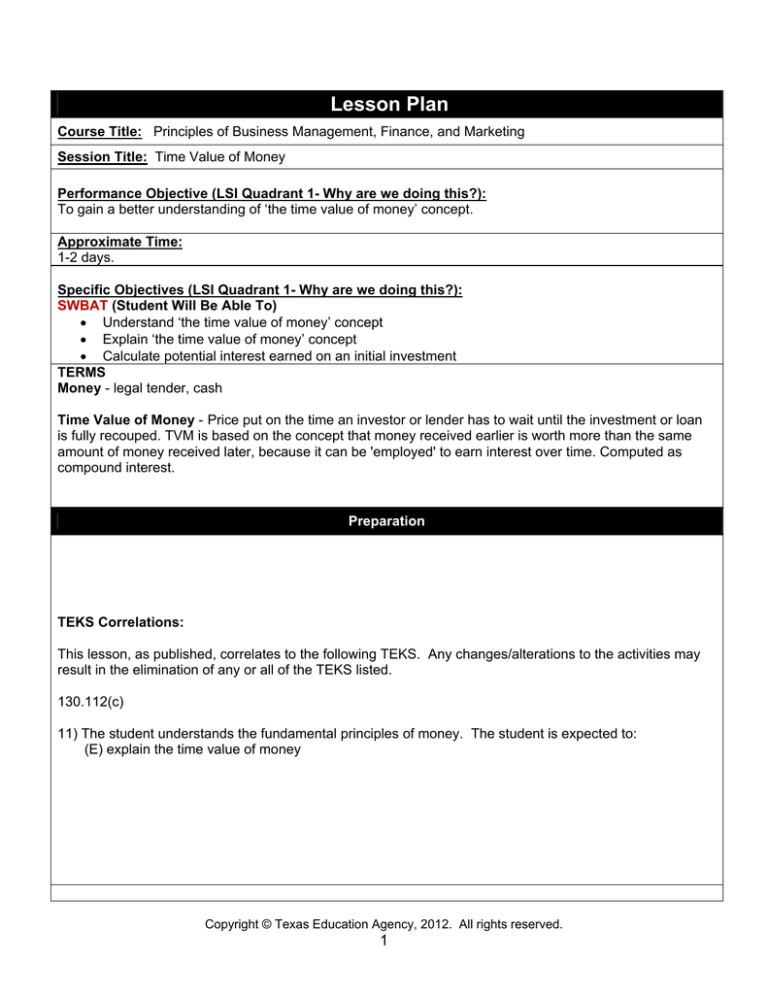
Lesson Plan Course Title: Principles of Business Management, Finance, and Marketing Session Title: Time Value of Money Performance Objective (LSI Quadrant 1- Why are we doing this?): To gain a better understanding of ‘the time value of money’ concept. Approximate Time: 1-2 days. Specific Objectives (LSI Quadrant 1- Why are we doing this?): SWBAT (Student Will Be Able To) Understand ‘the time value of money’ concept Explain ‘the time value of money’ concept Calculate potential interest earned on an initial investment TERMS Money - legal tender, cash Time Value of Money - Price put on the time an investor or lender has to wait until the investment or loan is fully recouped. TVM is based on the concept that money received earlier is worth more than the same amount of money received later, because it can be 'employed' to earn interest over time. Computed as compound interest. Preparation TEKS Correlations: This lesson, as published, correlates to the following TEKS. Any changes/alterations to the activities may result in the elimination of any or all of the TEKS listed. 130.112(c) 11) The student understands the fundamental principles of money. The student is expected to: (E) explain the time value of money Copyright © Texas Education Agency, 2012. All rights reserved. 1 Interdisciplinary Correlations: English-English 1 110.31(b)(1). Reading/Vocabulary Development. Students understand new vocabulary and use it when reading and writing. 110.31(b)(11). Reading/Comprehension of informational text/procedural texts. Students understand how to glean and use information in procedural texts and documents. Math-Algebra I 111.32(b)(1)(C). Interpret and make decisions, predictions, and critical judgments from functional relationships. Teacher Preparation: The teacher will review the terms in the outline, Power Point slides, and any handouts to become familiar with the lesson. Teacher should locate and evaluate various resources and websites before the lesson. Teacher will have assignments and website information ready to distribute to students. Occupational Correlation (O*Net – www.onetonline.org/) Job Title: Personal Financial Advisors O*Net Number: 13-2052.00 Reported Job Titles: Portfolio Manager, Financial Planner, Account Executive Tasks: Sell financial products such as stocks, bonds, mutual funds, and insurance if licensed to do so. Analyze financial information obtained from clients to determine strategies for meeting clients' financial objectives. Review clients' accounts and plans regularly to determine whether life changes, economic changes, or financial performance indicate a need for plan reassessment. Soft Skills: Giving full attention to what other people are saying, taking time to understand the points being made, asking questions as appropriate, and not interrupting at inappropriate times. The ability to tell when something is wrong or is likely to go wrong. It does not involve solving the problem, only recognizing there is a problem. Actively looking for ways to help people. References: http://www.tea.state.tx.us/index2.aspx?id=6148&menu_id=720&menu_id2=785 Instructional Aids: Lesson 6.3-Time Value of Money presentation Copyright © Texas Education Agency, 2012. All rights reserved. 2 Materials Needed: Time Value of Money Worksheet Time Value of Money Worksheet Key Time Value of Money Quiz Time Value of Money Quiz Key Equipment/Software Needed: Computers Internet Spreadsheet program Learner Preparation: Ask students if they’ve heard the phrase, “Time is money.” Discuss the meaning and examples of this. Introduction Introduction (LSI Quadrant I- Why are we doing this lesson?): To help students gain a better understanding of all the different types of currency out there, how we use it, and where we can get it. ASK: SAY: ASK: ASK: ASK: ASK: ASK: Is it possible for a person to make money while they aren’t working? Like, while they’re sleeping. Finish this statement…’Money is_____________’ Why did you answer the way you answered? Why do we all want money? Do you think everyone deserves to have as much money as they want? Why do you think some people have money and others don’t? What would you be willing to do to make money? What would you not be willing to do to make money? Outline Outline (LSI Quadrant II- What are we doing in this lesson?): Instructors can use the presentation slides, handouts, and note pages in conjunction with the following outline. MI Outline I. Notes to Instructor Discovery A. Ask students the question, ‘Which is better? To get $10,000 today or wait until 3 years from now and get the $10,000? Most students will say ‘now,’but why they want it now is where you’ll start to explain the time value of money. Most will want the money now so they can spend it...but what about the other reasons why getting the money now would be better? Copyright © Texas Education Agency, 2012. All rights reserved. 3 B. ask why they answered the way they did. Verbal Linguistic Logical Mathemati cal II. Introduction A. Introduce the ‘why’ of the lesson 1. Why we are doing this assignment 2. Need to Know Terms III. Guided Practice A. Have students go to online and find at least one article to help provide a better understanding of the time value of money concept. B. Download/Hand out the Time Value of Money Worksheet found with this lesson. Use the provided objective and terms by method of choice. IV. Independent Practice A. Time Value of Money Worksheet. Go through the first one, and then let them do the others on their own. V. Summary A. Re-state the objectives and check for understanding on how to calculate interest on an initial investment. Restate the lesson objectives and then do a quick check for understanding on how to calculate interest on an initial investment. This work can be graded in class or by you, the teacher. Visual Spatial Musical Rhythmic Bodily Kinesthetic Intrapersonal Once you’ve explained the concept, or let the article(s) explain, the time value of money, get students ready to work on their own (or with a partner) on the Time Value of Money Worksheet. Interpersonal Application Copyright © Texas Education Agency, 2012. All rights reserved. 4 Naturalist Existentia list Guided Practice (LSI Quadrant III- How are we going to do this?): Have students download at least one article dealing with the time value of money and read for understanding. You may direct them to the same article so that the information is received clearly. Have students download (or you provide a hard copy handout) of the Time Value of Money Worksheet. Go over directions and then get them started in the right direction on how to fill in the required information. Independent Practice (LSI Quadrant III- How are we going to do this?): Students will work on their own (or with partners/in groups) to complete the investment table. Summary Review (LSI Quadrants I- Why are we doing this lesson? and IV -Extending the lesson): We are doing this so students will be able to see what investing can do for a person as opposed to immediate spending…thus, getting across the concept of the time value of money. To extend the lesson, you can have students research to find actual interest rates offered, have them set up different sheet tabs/tables with the information, and calculate to compare and contrast their options. Evaluation Informal Assessment (LSI Quadrant III): Walk around and spot check students as they work on their own. Give deadlines for different stages of the assignment. The Time Value of Money Worksheet Formal Assessment (LSI Quadrant III, IV): Time Value of Money Quiz Formal Assessment (LSI Quadrant III- How are we going to do this?) Students will be tested over calculating simple compounded interest for an initial investment for a specific period of time. Quiz and Key are provided. Extension Extension/Enrichment (LSI Quadrant IV- Extending the lesson): To extend the lesson, you can have students research to find actual interest rates offered, have them set up different sheet tabs/tables with the information, and calculate to compare and contrast their options. Copyright © Texas Education Agency, 2012. All rights reserved. 5 Investment Amount Interest Rate Time January February March April May June July August September October November December $ 10,000.00 1.25% 1 year Start Amount Interest Earned End Amount $ 10,000.00 $ 125.00 $ 10,125.00 $ 10,125.00 $ 126.56 $ 10,251.56 Note: If you know how to set up an absolute value and use the fill handle, this can be quickly filled in with the correct information. Copyright © Texas Education Agency, 2012. All rights reserved. Investment Amount Interest Rate Time $ 10,000.00 1.25% 1 year January February March April May June July August September October November December Start Amount $ 10,000.00 $ 10,125.00 $ 10,251.56 $ 10,379.71 $ 10,509.45 $ 10,640.82 $ 10,773.83 $ 10,908.50 $ 11,044.86 $ 11,182.92 $ 11,322.71 $ 11,464.24 Interest Earned $ 125.00 $ 126.56 $ 128.14 $ 129.75 $ 131.37 $ 133.01 $ 134.67 $ 136.36 $ 138.06 $ 139.79 $ 141.53 $ 143.30 End Amount $ 10,125.00 $ 10,251.56 $ 10,379.71 $ 10,509.45 $ 10,640.82 $ 10,773.83 $ 10,908.50 $ 11,044.86 $ 11,182.92 $ 11,322.71 $ 11,464.24 $ 11,607.55 Note: If you know how to set up an absolute value and use the fill handle, this can be quickly filled in with the correct information. Copyright © Texas Education Agency, 2012. All rights reserved. Investment Amount Interest Rate Time $5,000 2.00% 1 year Initial Investment Interest Earned January February March April May June July August September October November December Copyright © Texas Education Agency, 2012. All rights reserved. End Amount Investment Amount Interest Rate Time $5,000 2.00% 1 year January February March April May June July August September October November December Start Amount $ 5,000.00 $ 5,100.00 $ 5,202.00 $ 5,306.04 $ 5,412.16 $ 5,520.40 $ 5,630.81 $ 5,743.43 $ 5,858.30 $ 5,975.46 $ 6,094.97 $ 6,216.87 Interest Earned $ 100.00 $ 102.00 $ 104.04 $ 106.12 $ 108.24 $ 110.41 $ 112.62 $ 114.87 $ 117.17 $ 119.51 $ 121.90 $ 124.34 End Amount $ 5,100.00 $ 5,202.00 $ 5,306.04 $ 5,412.16 $ 5,520.40 $ 5,630.81 $ 5,743.43 $ 5,858.30 $ 5,975.46 $ 6,094.97 $ 6,216.87 $ 6,341.21 Copyright © Texas Education Agency, 2012. All rights reserved.
